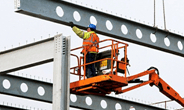Analysis

June 5, 2022
April Construction Spending Down on Workforce Shortages: AGC
Written by David Schollaert
Spending on nonresidential construction projects declined for the second straight month in April because labor shortages suppressed construction activity, the Associated General Contractors of America (AGC) reported.
![]() “Nonresidential construction spending is being held back by a paucity of qualified workers, not a lack of projects,” AGC chief economist Ken Simonson said. “With job openings at an all-time high and the industry’s unemployment rate at the lowest ever for April, finding workers is contractors’ top concern.”
“Nonresidential construction spending is being held back by a paucity of qualified workers, not a lack of projects,” AGC chief economist Ken Simonson said. “With job openings at an all-time high and the industry’s unemployment rate at the lowest ever for April, finding workers is contractors’ top concern.”
Construction spending, not adjusted for inflation, totaled $1.74 trillion at a seasonally adjusted annual rate in April, 0.2% above the upwardly revised March rate and 12.3% higher year on year (YoY). But monthly gains were limited to private residential construction spending, which rose 0.9% for the month and 18.4% YoY.
In contrast, private nonresidential construction spending dipped 0.2% month on month (MoM) in April, although the April total was 10.1% higher YoY. Public construction spending slid 0.7% for the month but increased 1.8% from same the year-ago level.
Job openings in construction at the end of April totaled 494,000, a 40% increase from April 2021 and the highest total for any month in the series (which dates to December 2000), AGC said.
Openings exceeded the 455,000 workers hired during the month, suggesting that contractors would have hired twice as many workers as they were able to find. A major reason unfilled positions were at an all-time high was that the unemployment rate for jobseekers with construction experience set a record low for April of 4.6%, Simonson said.
The downturn in nonresidential construction spending was widespread. The largest segment, power – comprising electric, oil, and gas projects – slipped 1.5% in April. Highway and street construction edged down 0.2%. Spending on commercial construction – warehouse, retail, and farm projects – and on education structures each declined 0.4%. Among the five largest segments, only manufacturing construction increased, a 1.7% gain driven by a variety of factory projects.
Workforce shortages are now so severe they are undermining construction activity, AGC said. The association continued to urge public officials to boost funding and support for construction education and training programs for students and adult workers. They also called on Congress and the Biden administration to work together to allow more workers with construction skills to legally enter the country in the short term.
“We are ready to work with public leaders to undertake the long-term work of rebuilding the domestic pipeline for recruiting and preparing a new generation of construction professionals,” AGC CEO Stephen E. Sandherr said. “But without short-term relief measures, like allowing more workers to legally enter the country, the economy will continue to suffer because we lack the people power to keep pace with demand for construction.”
By David Schollaert, David@SteelMarketUpdate.com







